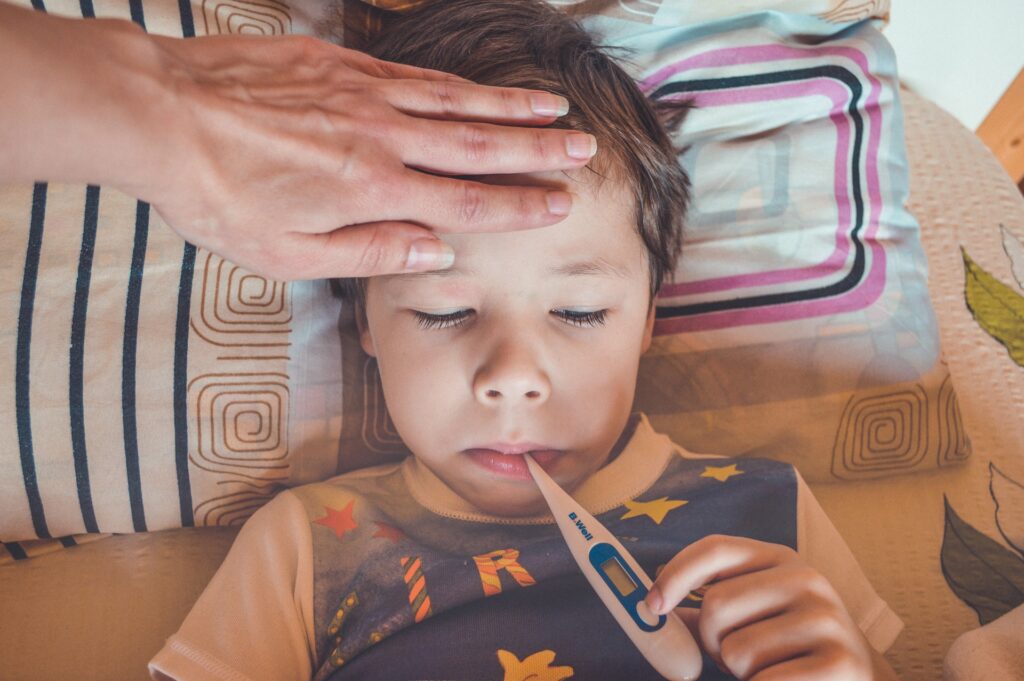Flu season is in mid-swing, so we want to help families understand what’s making the rounds this time of year – and which symptoms are most likely to show up if your child catches a bug.
Common Symptoms of Various Winter Illnesses
Here is a list of five of the most common winter illnesses circulating during the winter months. Excluding emergencies, we always recommend contacting the 24/hour nurse line (503-227-0671) when your child experiences symptoms. A quick check-in may be all that’s necessary. And, in some cases, we may recommend a video consult, preventing you from having to get a sick kiddo out of the house and in the car if you don’t need to.
Exposing a sick child to a waiting room of other sick (or well) patients is only recommended when absolutely necessary. More often than not, staying home, getting plenty of rest, eating nourishing foods, and staying hydrated is the key to recovery. Remember that antibiotics are rarely needed to treat most colds and flus, so never administer them unless a physician instructs/prescribes otherwise.
Respiratory Syncytial Virus (RSV)
RSV is all over the news these days. And, while information is essential, there is no need to panic. Most patients with RSV recover just fine. Highly contagious, RSV affects children and adults but is the most serious for babies and toddlers two years old and younger due to their smaller respiratory systems and young immune systems.
Length: Two weeks (symptoms typically emerge and are worst during the first week)
Treatment: Keeping airways clear via saline baths and suction if necessary.
Hydration (if children aren’t eating much, consider using Pedialyte)
Common symptoms of RSV are:
- Fever
- Cough
- Sneezing
- Runny nose
- Congestion
- Fussiness
- Poor appetite
Again, all of these symptoms are normal and will resolve on their own. However, DO check in with your pediatrician if something doesn’t feel normal to you. This would include more intense symptoms, like:
- Wheezing
- Fast, shallow breathing pattern
- Nostril flaring
- Grunting when breathing
- Pauses or difficulty breathing
- Dehydration (less than 1 wet diaper every 8 hours)
- Gray or blue-colored tongue, lips, or skin
- Listlessness or decreased alertness (beyond the normal drowsiness or sleepiness associated with being sick – the body knows it needs rest to heal)
- Fever of 103° F or higher
- Fever that lasts longer than 3 days
The Common Flu
Flus are always viral (not caused by bacteria) and rarely require medical assistance other than reassuring parents and patients that things are just fine.
Here’s another reminder to never administer antibiotics unless a physician has determined an infection is bacterial. If you give a child antibiotics when they have a viral infection – rather than bacterial – you’ll wipe out all of the healthy bacteria (probiotics) their body needs to heal.
Length: 1 to 2 weeks
Treatment: Tamiflu – Only for high-risk populations if diagnosed within 48 hours (otherwise, it’s too late).
Rest
Hydration
Common flu symptoms:
- Body aches
- Lethargy/sleepiness
- Fever
- Runny nose
- Congestion
- Coughing
- Mild conjunctivitis (red or irritated eyes)
- Sometimes includes diarrhea or vomiting.
The Common Cold
Here’s another infection caused by one of multiple viruses rather than bacterial.
- Length: 5 to 14 days
- Treatment: Resist the urge to administer cold medicine, especially to children under the age of six, unless recommended by your pediatrician.
- Hydration
- Nasal saline flushing and suction (only as needed)
- Lots of rest
Common cold symptoms:
- Running nose
- Sneezing/coughing
- Congestion
- Headache
- Sore throat
- Possible fever, although fevers associated with a cold tend to be lower-grade and shorter-lived than with the flu.
Strep Throat
Here’s a bacterial infection that is relatively common (most people get strep at least two or three times in their life) and does require antibiotics to prevent it from becoming more serious.
Length: Symptoms resolve within 24 to 28 hours of treatment, and early treatment is essential!
Treatment: Antibiotics (we typically start with Amoxycillin or penicillin unless a patient is allergic)
Take it easy until they complete the antibiotic run.
Symptoms of strep throat:
- Sore throat
- Difficulty swallowing
- Headache
- Fever
- White or yellowish spots on the tonsils or back of the throat
- Sometimes accompanied by stomach pain.
- Advanced symptoms can include a scarlet rash on cheeks, neck, and chest and a white coating on the tongue that may slough off to reveal a red “strawberry tongue.”
Strep throat can develop into rheumatic fever (scarlet fever) and affect the heart and other organs, so early treatment is essential. Unfortunately, until the advent of antibiotics, progressed strep throat was a leading cause of early childhood fatality.
Stomach Flu
It’s never fun to have a sick child, but the stomach flu is the real pits for a parent before a little one learns to tell you their stomach is upset. The stomach flu is a viral infection. Sometimes, you may even mistake a mild food-borne (bacterial) illness for the stomach flu, but the symptoms are the same.
- Length: 1 to 5 days (fingers crossed for the 24-hour type!)
- Treatment: No medication unless excessive vomiting occurs. Then doctors may recommend Zofran.
- Hydration (Sometimes Pedialyte in small doses is easier to keep down than water)
Common stomach flu symptoms:
- Stomach pain/nausea
- Diarrhea
- Vomiting
- Mild fever
- Headache
- Fatigue
Concerned About Common Winter Illness Symptoms?
The last thing parents and caregivers need to do is worry about whether or not to see a doctor. The Pediatric Associates of the Northwest (PANW) invites you to call us anytime (503-227-0671) day, night, or wee hours – if you’d like a check your child’s symptoms with a nurse or physician. Our goal is to provide accurate information and put your mind at ease. We’ll let you know what we think, and we always err on the side of caution.
In the meantime, support your immune systems by eating well, keeping hydrating, exercising regularly, and observing good hand/coughing and nose-blowing hygiene!





